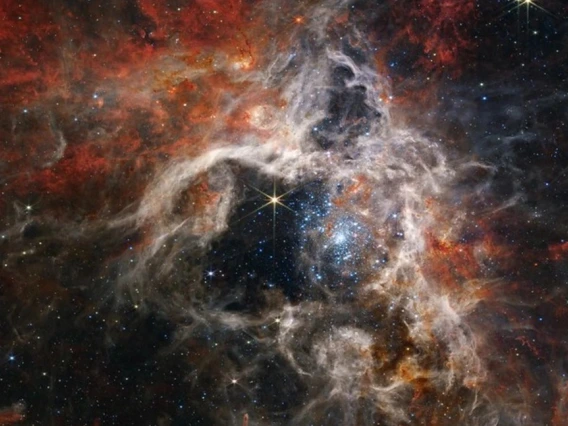
U of A Earns Top Marks in Space Science, Geosciences, Water Resources in New US News Global Ranking
The U of A earned its best ranking in the space science category, rising four spots to No. 4 globally and No. 2 among U.S. public universities.U of A Earns Top Marks in Space Science, Geosciences, Water Resources in New US News Global Ranking
×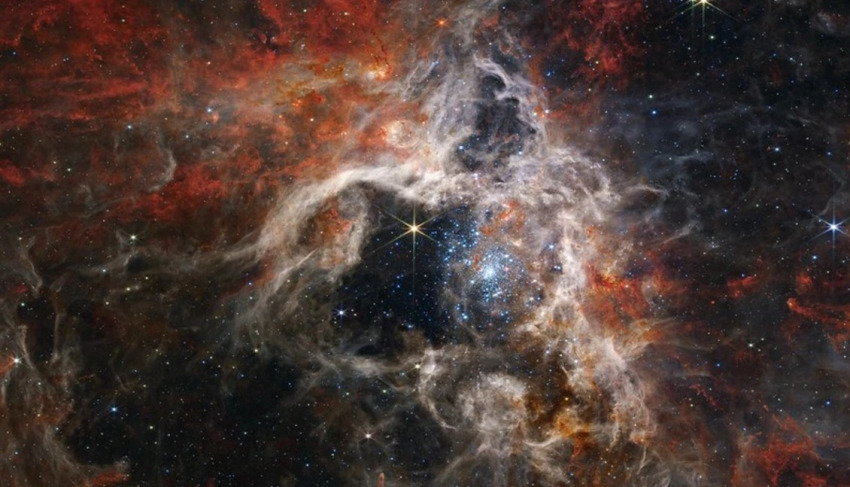
By University Communications - June 17, 2025
U.S. News & World Report has once again recognized the University of Arizona as one of the world's top research institutions.
The U of A ranked No. 115 out of 2,250 higher education institutions across more than 100 countries in the 2025-2026 Best Global Universities ranking, released Tuesday. The university ranked No. 44 among universities in the U.S. and No. 23 among public U.S. universities.
The ranking placed the U of A among the top 10% of all ranked universities across the globe.
The U of A again earned its best ranking in the space science category, rising four spots to No. 4 globally and No. 2 among U.S. public universities. The university earned top marks in this category for its research reputation, along with the number of citations and publications by U of A researchers.
The U of A also ranked highly in water resources (No. 2 in the U.S., No. 31 globally) and geosciences (No. 10 in the U.S., No. 25 globally).
Additional top-100 global placements include the U of A's programs in meteorology and atmospheric sciences (No. 45), environment/ecology (No. 62), plant/animal sciences (tied for No. 77) and arts and humanities (tied for No. 88).
U.S. News & World Report's Best Global Universities ranks colleges and universities in 51 subjects. The University of Arizona earned a spot on 35 of the subject ranking lists.
The university's overall research reputation was ranked No. 47 in the U.S. and No. 101 globally.
The 11th annual Best Global Universities rankings provide insight into how research institutions compare throughout the world. To produce the global rankings, which are based on data and metrics provided by the analytics company Clarivate, U.S. News & World Report uses a methodology that focuses on a university's global and regional reputation and academic research performance using indicators such as citations and publications.
U.S. News uses a separate methodology for the subject-specific rankings that is based on academic research performance in each subject. U.S. News uses various measures, including publications and citations as well as indicators for global and regional reputation in each specific subject area.
UA News - U of A Earns Top Marks in Space Science, Geosciences, Water Resources in New US News Global Ranking
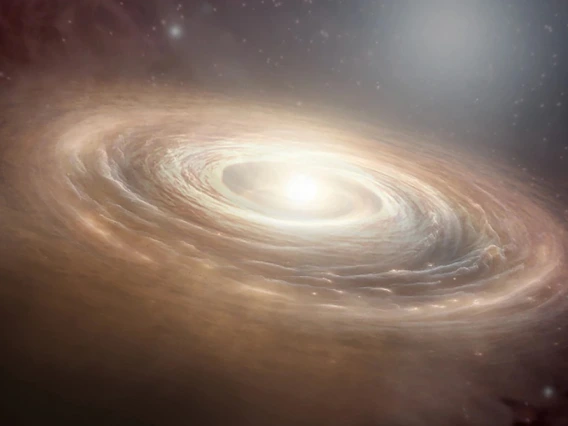
Revealing the Lives of Planet-Forming Disks
New observations of 30 planet-forming disks - the birthplaces of planets around stars - reveal in greater detail than ever how gas and dust behave over time and shape the evolution of exoplanet systems.Revealing the Lives of Planet-Forming Disks
×
By National Radio Astronomy Observatory (NRAO) and Daniel Stolte, University Communications June 13, 2025
An international team of astronomers including researchers at the University of Arizona Lunar and Planetary Laboratory has unveiled groundbreaking findings about the disks of gas and dust surrounding nearby young stars, using the powerful Atacama Large Millimeter/submillimeter Array, or ALMA.
The findings, published in 12 papers in a focus issue of the Astrophysical Journal, are part of an ALMA large program called the ALMA Survey of Gas Evolution of PROtoplanetary Disks, or AGE-PRO. AGE-PRO observed 30 planet-forming disks around sunlike stars to measure gas disk mass at different ages. The study revealed that gas and dust components in these disks evolve at different rates.
Prior ALMA observations have examined the evolution of dust in disks; AGE-PRO, for the first time, traces the evolution of gas, providing the first measurements of gas disk masses and sizes across the lifetime of planet-forming disks, according to the project's principal investigator, Ke Zhang of the University of Wisconsin-Madison.
"Now we have both, the gas and the dust," said Ilaria Pascucci, a professor at planetary sciences at the U of A and one of three AGE-PRO co-principal investigators. "Observing the gas is much more difficult because it takes much more observing time, and that's why we have to go for a large program like this one to obtain a statistically significant sample."
A protoplanetary disk swirls around its host star for several million years as its gas and dust evolve and dissipate, setting the timescale for giant planets to form. The disk's initial mass and size, as well as its angular momentum, have a profound influence on the type of planet it could form – gas giants, icy giants or mini-Neptunes – and migration paths of planets. The lifetime of the gas within the disk determines the timescale for the growth of dust particles to an object the size of an asteroid, the formation of a planet and finally the planet's migration from where it was born.
In one of the survey's most surprising findings, the team discovered that as disks age, their gas and dust are consumed at different rates and undergo a shift in gas-to-dust mass ratio as the disks evolve: Unlike the dust, which tends to remain inside the disk over a longer time span, the gas disperses relatively quickly, then more slowly as the disk ages. In other words, planet-forming disks blow off more of their gas when they're young.
Zhang said the most surprising finding is that although most disks dissipate after a few million years, the ones that survive have more gas than expected. This would suggest that gaseous planets like Jupiter have less time to form than rocky planets.
ALMA's unique sensitivity allowed researchers to use faint, so-called molecular lines to study the cold gas in these disks, characteristic wavelengths of a light spectrum that essentially act as "fingerprints," identifying different species of gas molecules. The first large-scale chemical survey of its kind, AGE-PRO targeted 30 planet-forming disks in three star-forming regions, ranging from 1 million to 6 million years in age: Ophiuchus (youngest), Lupus (1-3 million years old), and Upper Scorpius (oldest). Using ALMA, AGE-PRO obtained observations of key tracers of gas and dust masses in disks spanning crucial stages of their evolution, from their earliest formation to their eventual dispersal. This ALMA data will serve as a comprehensive legacy library of spectral line observations for a large sample of disks at different evolutionary stages.
Dingshan Deng, a graduate student at LPL who is the lead author on one of the papers, provided the data reduction – essentially, the image analyses needed to get from radio signals to optical images of the disks – for the star-forming region in the constellation of Lupus (Latin for "wolf").
"Thanks to these new and long observations, we now have the ability to estimate and trace the gas masses, not only for the brightest and better studied disks in that region, but also the smaller and fainter ones," he said. "Thanks to the discovery of gas tracers in many disks where it hadn't been seen before, we now have a well-studied sample covering a wide range of disk masses in the Lupus star-forming region."
"It took years to figure out the proper data reduction approach and analysis to produce the images used in this paper for the gas masses and in many other papers of the collaboration," Pascucci added.
Carbon monoxide is the most widely used chemical tracer in protoplanetary disks, but to thoroughly measure the mass of gas in a disk, additional molecular tracers are needed. AGE-PRO used N2H+, or diazenylium, an ion used as an indicator for nitrogen gas in interstellar clouds, as an additional gas tracer to significantly improve the accuracy of measurements. ALMA's detections were also set up to receive spectral light signatures from other molecules, including formaldehyde, methyl cyanide and several molecular species containing deuterium, a hydrogen isotope.
"Another finding that surprised us was that the mass ratio between the gas and dust tends to be more consistent across disks of different masses than expected," Deng said. "In other words, different-size disks will share a similar gas-to-dust mass ratio, whereas the literature suggested that smaller disks might shed their gas faster."
Funding for this study was provided by the National Science Foundation, the European Research Council, the Alexander von Humboldt Foundation, FONDECYT (Chile) among other sources. For full funding information, see the research paper.
UA News - Revealing the Lives of Planet-Forming Disks
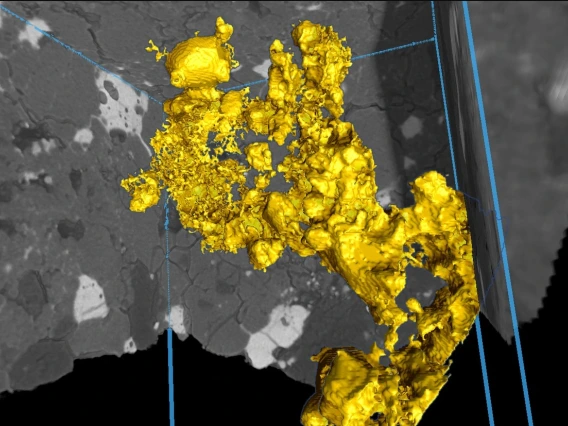
Percolating Clues: A New Way to Build Planetary Cores
Molten sulfide can migrate and coalesce within a solid planetary interior, according to a new experimental study published in Nature Communications.Percolating Clues: A New Way to Build Planetary Cores
×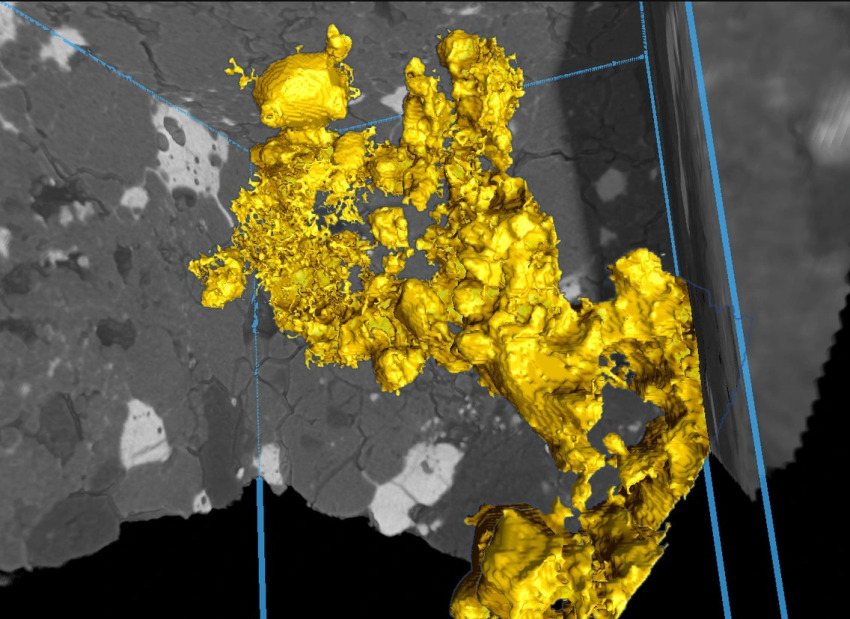
By NASA and Daniel Stolte, University Communications - May 22, 2025
A new study led by Sam Crossley at the University of Arizona Lunar and Planetary Laboratory reveals a surprising new way planetary cores formed. The findings could reshape how scientists understand the early evolution of rocky planets like Mars.
Published in Nature Communications, the study offers the first direct experimental and geochemical evidence that molten sulfide, rather than metal, can percolate through solid rock and form a core, even before a planet's silicate mantle begins to melt.
The study was conducted by a team of early-career scientists and long-time researchers across the Astromaterials Research and Exploration Science, or ARES, Division at NASA's Johnson Space Center.
Image Crossley and Anzures use welding equipment as part of their research Trading lab coats for welding goggles, the research team set out to recreate planetary conditions in the lab. Here, Crossley and Anzures are seen working together to develop new experimental assembly designs and methodologies for melting experiments. Amentum/Kayla Iacovino
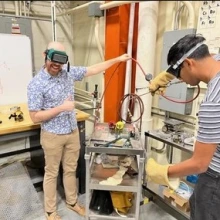
Trading lab coats for welding goggles, the research team set out to recreate planetary conditions in the lab. Here, Crossley and Anzures are seen working together to develop new experimental assembly designs and methodologies for melting experiments. Amentum/Kayla Iacovino
Planets in the early solar system began their lives by coalescing from gas, dust and ice. As they grew, heat produced from the decay of radioactive elements caused minerals to begin melting, providing a pathway for a planet to segregate into the familiar layered structure of core, mantle and crust. For decades, scientists believed that forming a core required large-scale melting of a planetary body, followed by heavy metallic elements sinking to the center. This study introduces a new scenario, by which cores could have begun forming earlier and without the need for the young planet to undergo melting as a whole.
The results, according to the research team, are especially relevant for planets forming farther from the sun. There, in the solar system's outer reaches, abundant volatiles like sulfur and oxygen behave like road salt on an icy street – lowering the melting point of metals by reacting with iron metal to form iron-sulfide. This destabilizes the metals and allows them to migrate and combine into a core. The problem? Until now, scientists didn't know if sulfide could travel through solid rock under realistic planet formation conditions.
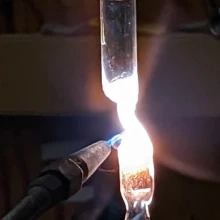
Sam Crossley welds shut the glass tube of the experimental assembly. To prevent reaction with the atmosphere and precisely control oxygen and sulfur content, experiments needed to be sealed in a closed system under vacuum. - Amentum/Brendan Anzures
"We could actually see in full 3D renderings how the sulfide melts were moving through the experimental sample, percolating in cracks between other minerals," Crossley said. "It confirmed our hypothesis – that in a planetary setting, these dense melts would migrate to the center of a body and form a core, even before the surrounding rock began to melt.”
Recreating planetary conditions in the lab required not only experimental precision but also close collaboration among early-career scientists across ARES to develop new ways of observing and analyzing the results. The team used chips of genuine meteorites as well as synthetic minerals doped with trace amounts of noble metals to observe how those elements behave during this melt percolation process.
As molten sulfide moved through solid rock at high temperatures in a lab experiment, Scott Eckley, an X-ray scientist at ARES, used X-ray computed tomography to produce high-resolution 3D renderings – revealing melt pockets and flow pathways within the samples in microscopic detail. These visualizations offered insight into the physical behavior of materials during early core formation without destroying the sample.
To understand the distribution of trace elements, study co-author Jake Setera developed a laser ablation technique to trace noble metals such as platinum, palladium and iridium, which are known to concentrate in iron metal found in planetary cores and meteorites. These elements tend to "prefer" metals and sulfides over silicate rock, making them ideal indicators of core formation processes.
"We searched for forensic evidence of sulfide percolation in meteorites," Crossley explained. "By partially melting synthetic sulfides doped with trace metals, we were able to reproduce the same anomalous chemistries we'd previously seen in oxidized meteorites. That was a strong indication that percolative sulfide core formation had actually occurred in the early solar system."
When paired with Setera's geochemical analysis, the geochemical data provided powerful, independent lines of evidence that molten sulfide had migrated and coalesced within a solid planetary interior – a process that, until now, had not been directly confirmed in a laboratory setting.
The study offers a new lens through which to interpret planetary geochemistry. Mars in particular, shows signs of early core formation – but the timeline has puzzled scientists for years. The new results suggest that Mars' core may have formed more efficiently, and therefore more rapidly and sooner, due to its sulfur-rich composition, potentially without needing to first undergo full-scale melting like Earth did.
The results also raise new questions about how scientists date core formation events using radiogenic isotopes, such as hafnium and tungsten. If sulfur and oxygen are more abundant during a planet's formation, certain elements may behave differently than expected – remaining in the mantle instead of the core and affecting the geochemical "clocks" used to estimate timelines of planet formation and evolution.
"This study advances our understanding of how planetary interiors can form under different chemical conditions – offering new possibilities for interpreting the evolution of rocky bodies like Mars," Crossley said.
As NASA prepares for future missions to the moon, Mars and beyond, understanding how planetary interiors form is more important than ever. Studies like this one help scientists interpret remote data from spacecraft, analyze returned samples and build better models of how our solar system came to be.
Crossley led the research during his time as a McKay Postdoctoral Fellow – a program that recognizes outstanding early-career scientists within five years of earning their doctorate. Jointly offered by NASA's ARES Division and the Lunar and Planetary Institute, the fellowship supports innovative research in astromaterials science.
UA News - Percolating Clues: A New Way to Build Planetary Cores
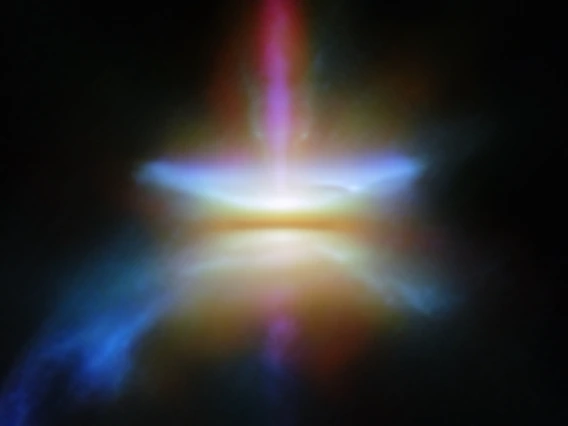
Winds, Jets, and Wigglings from Young Stars and Their Disks
New JWST observations provide a detailed look at the jets of four young stars, revealing shocks, mass loss, and wiggly behavior that hints at a hidden binary companion.Winds, Jets, and Wigglings from Young Stars and Their Disks
×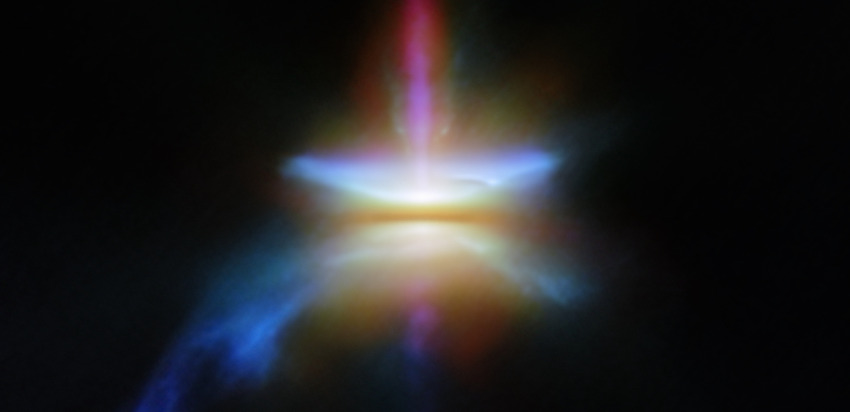
By Kerry Hensley, AAS - May 14, 2025
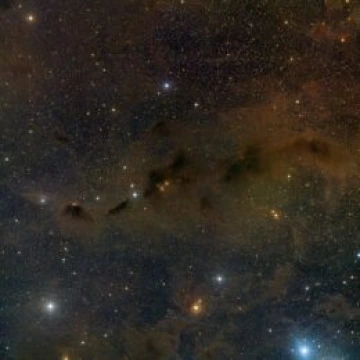
A portion of the Taurus star-forming region. [ESO/Digitized Sky Survey 2. Acknowledgement: Davide De Martin; CC BY 4.0]
From Cloud to Star to Planetary System
The transformation from a turbulent cloud of hydrogen gas to a star circled by planets is complicated. As stars coalesce from their natal clouds, they gather gas from their surroundings and flatten it into a dense, dusty disk. While feeding on the gas from this disk, young stars launch powerful, narrow jets and broad, slower-moving winds. As accretion slows, planets begin to form, getting their start from clumps of dust grains.
In a recent research article, JWST observations give insight into the details of this process, illuminating the winds and jets of the disks surrounding young stars.
JWST’s View
Naman Bajaj (Lunar and Planetary Laboratory, The University of Arizona) and collaborators investigated four protoplanetary disks with JWST’s Near Infrared Spectrograph (NIRSpec). The four disks — Tau 042021, HH 30, FS Tau B, and IRAS 04302 — reside in the Taurus star-forming region, which is 1–2 million years old and roughly 450 light-years away.
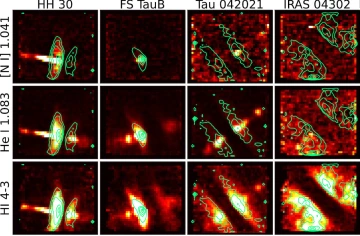
JWST images of the four disks as seen in a selection of emission lines. Green contour lines show the location of continuum emission. [Adapted from Bajaj et al. 2025]
Each of these disks displays narrow jets that emerge perpendicularly above and below the disk, nested within broad, cone-shaped winds. The disks were selected for their edge-on appearance, which highlights the jets and winds that emerge from the disk.
Bajaj’s team identified more than 40 emission lines for each disk, allowing them to determine the properties of the jets, such as the density and shock speed. One important aspect that can be gleaned from these observations is an estimate of the mass carried away by the jets. Using three independent methods, the team found that jet mass-loss rates for the four disks was on average a billionth of a solar mass per year.
The Wiggly Jet of Tau 042021
Though appearing to jut straight out from the disk, each of the jets studied showed signs of side-to-side wiggles. Tau 042021’s jets are especially interesting, displaying mirror-symmetric wiggling, in which the redshifted and
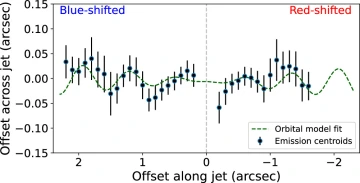
Observed locations of the center of the redshifted and blueshifted jets (circles) as well as a fit to a binary orbit model (green dashed line). [Bajaj et al. 2025]
blueshifted wiggles mirror one another. At present, the only explanation for these synchronized wiggles is a binary companion. By modeling the jet wiggles as emanating from a star in a binary system, the authors concluded that Tau 042021 likely contains a 0.33-solar-mass star and a 0.07-solar-mass star in a 2.5-year orbit with a separation of 1.35 au.
Bajaj and coauthors presented a rich dataset that illuminates the behavior of jets from young stars, and their work isn’t yet done; this is the second research article the team has produced from these data, and more are in the works.
Citation
“Class I/II Jets with JWST: Mass-Loss Rates, Asymmetries, and Binary-Induced Wigglings,” Naman S. Bajaj et al 2025 AJ 169 296. doi:10.3847/1538-3881/adc73c
AAS - Winds, Jets, and Wigglings from Young Stars and Their Disks
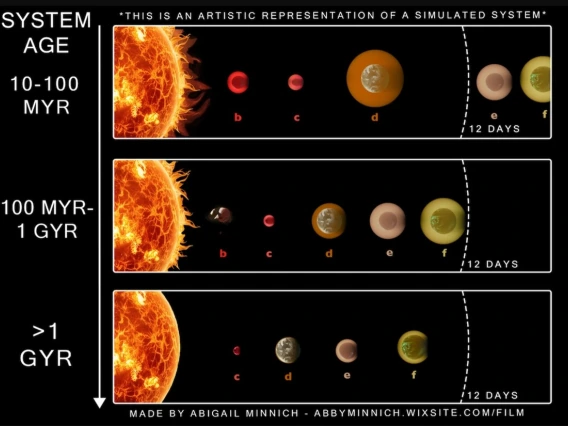
Combination of Cosmic Processes Shapes the Size and Location of Sub-Neptunes
A combination of cosmic processes shapes the formation of one of the most common types of planets outside of our solar system, a new study finds. The research team, which included University of Arizona planetary scientists, used data from NASA's Transiting Exoplanet Survey Satellite, or TESS, to study young sub-Neptunes - planets bigger than Earth but smaller than Neptune - that orbit close to their stars.Combination of Cosmic Processes Shapes the Size and Location of Sub-Neptunes
×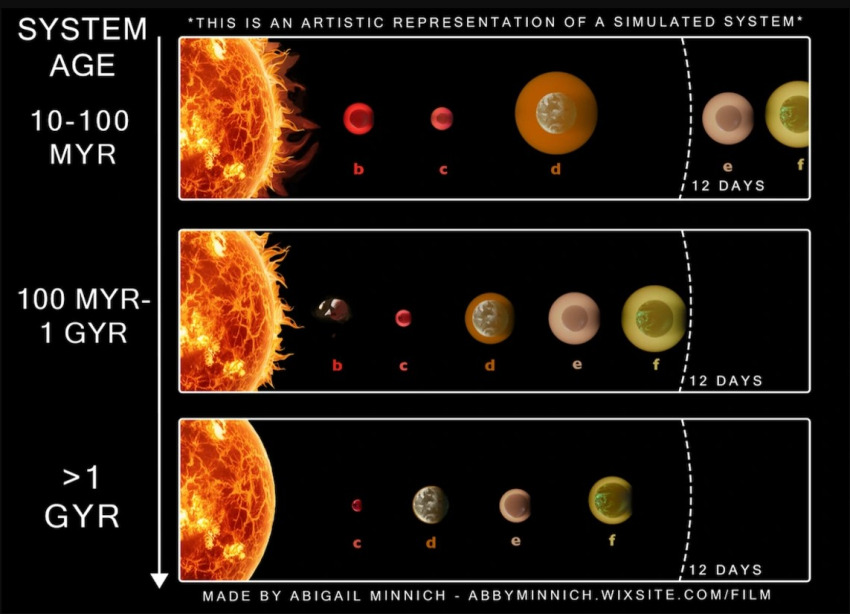
By Penn State Eberly College of Science Communications and Niranjana Rajalakshmi/University Communications - March 18, 2025
A combination of cosmic processes shapes the formation of one of the most common types of planets outside of our solar system, a new study finds.
The research team, which included University of Arizona planetary scientists, used data from NASA's Transiting Exoplanet Survey Satellite, or TESS, to study young sub-Neptunes – planets bigger than Earth but smaller than Neptune – that orbit close to their stars. The work provides insights into how these planets might migrate inward or lose their atmosphere during their early stages.
A paper describing the research was published Monday in the Astronomical Journal. The findings offer clues about the properties of sub-Neptunes and help address long-standing questions about their origins.
"The majority of the 5,500 or so exoplanets discovered to date have a very close orbit to their stars, closer than Mercury to our sun, which we call ‘close-in’ planets," said Rachel Fernandes, a U of A alumnus who led the research team and is now a President's Postdoctoral Fellow in the Department of Astronomy and Astrophysics at Penn State University. "Many of these are gaseous sub-Neptunes, a type of planet absent from our own solar system. While our gas giants like Jupiter and Saturn formed farther from the sun, it’s unclear how so many close-in sub-Neptunes managed to survive near their stars, where they are bombarded by intense stellar radiation."
The project began when Fernandes was a graduate student at the U of A Lunar and Planetary Laboratory.
"Our work provides one of the first glimpses into young planet populations, about which we haven't had a lot of insights so far," said study co-author Galen Bergsten, a graduate student at the U of A Lunar and Planetary Laboratory.
The research gives a peek into what was happening very early on for these planets, said Bergesten, who handled the statistics and modeling for the study.
To better understand how sub-Neptunes form and evolve, the researchers turned to planets around young stars, which only recently became observable thanks to TESS.
"Comparing the frequency of exoplanets of certain sizes around stars of different ages can tell us a lot about the processes that shape planet formation," Fernandes said. "If planets commonly form at specific sizes and locations, we should see a similar frequency of those sizes across different ages. If we don't, it suggests that certain processes are changing these planets over time."
Observing planets around young stars, however, has traditionally been difficult. Young stars emit bursts of intense radiation, rotate quickly and are highly active, creating high levels of "noise" that make it challenging to observe planets around them.
"These stellar tantrums cause a lot of noise in the data, so we spent the last six years developing a computational tool called Pterodactyls to see through that noise and actually detect young planets in TESS data," Fernandes said.
The research team used Pterodactyls to evaluate TESS data and identify planets with orbital periods of 12 days or less – for reference, much less than Mercury's 88-day orbit – with the goal of examining the planet sizes, as well as how the planets were shaped by the radiation from their host stars. Because the team's survey window was 27 days, the researchers were able to see two full orbits from potential planets. They focused on planets between a radius of 1.8 and 10 times the size of Earth, allowing the team to see if the frequency of sub-Neptunes is similar or different in young systems versus older systems previously observed with TESS and NASA's retired Kepler Space Telescope.
The researchers found that the frequency of close-in sub-Neptunes changes over time, with fewer sub-Neptunes around stars between 10 million and 100 million years of age compared to those between 100 million and 1 billion years of age. However, the frequency of close-in sub-Neptunes is much less in older, more stable systems.
"I found particularly striking that the occurrence rate wasn't uniformly high in the past. Instead, it started off lower, then increased, only to drop significantly when stars are billions of years in age – strongly suggesting that different physical processes shape planetary populations at different stages," said study co-author Ilaria Pascucci, a professor at the U of A Lunar and Planetary Laboratory.
It's possible that many sub-Neptunes originally formed farther away from their stars and slowly migrated inward over time, so we see more of them at this orbital period in the intermediate age. In later years, it's possible that planets are more commonly shrinking when radiation from the star essentially blows away its atmosphere, a process called atmospheric mass loss, that could explain the lower frequency of sub-Neptunes. But it's likely a combination of cosmic processes shaping these patterns over time rather than one dominant force, Fernandes said.
"Combining studies of individual planets with the population studies like we conducted here would give us a much better picture of planet formation around young stars," Fernandes said. "The more solar systems and planets we discover, the more we realize that our solar system isn't really the template; it’s an exception. Future missions might enable us to find smaller planets around young stars and give us a better picture of how planetary systems form and evolve with time, helping us better understand how our solar system, as we know it today, came to be."
Funding from NASA, Chile’s National Fund for Scientific and Technological Development, and the U.S. National Science Foundation supported this research. Additional support was provided by the Penn State Center for Exoplanets and Habitable Worlds and the Penn State Extraterrestrial Intelligence Center. Computations for this research were performed with Penn State University’s Institute for Computational and Data Sciences’ Roar supercomputer.
UA News - Combination of Cosmic Processes Shapes the Size and Location of Sub-Neptunes
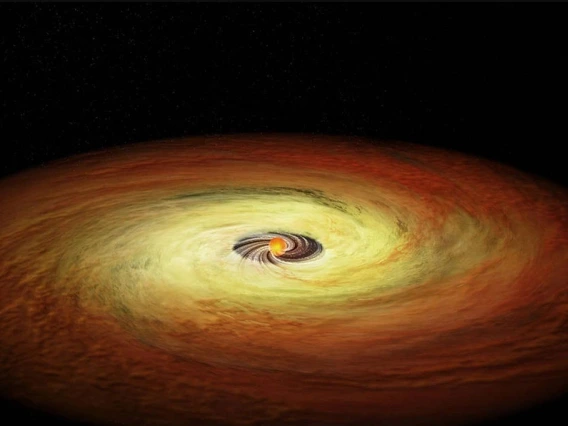
James Webb Telescope Reveals Planet-Forming Disks Can Last Longer Than Previously Thought
Researchers at the University of Arizona have discovered that planet-forming disks of gas and dust around tiny stars live much longer than previously thought. The findings provide new insights into planet formation and the habitability of planets outside our solar system.James Webb Telescope Reveals Planet-Forming Disks Can Last Longer Than Previously Thought
×
By Penny Duran, NASA Space Grant Science Writing Intern, University Communications - February 26, 2025
If there were such a thing as a photo album of the universe, it might include snapshots of pancake-like disks of gas and dust, swirling around newly formed stars across the Milky Way. Known as planet-forming disks, they are believed to be a short-lived feature around most, if not all, young stars, providing the raw materials for planets to form.
Most of these planetary nurseries are short-lived, typically lasting only about 10 million years – a fleeting existence by cosmic standards. Now, in a surprising find, researchers at the University of Arizona have discovered that disks can grace their host stars much longer than previously thought, provided the stars are small – one-tenth of the sun's mass or less.
In a paper published in the Astrophysical Letters Journal, a research team led by Feng Long of the U of A Lunar and Planetary Laboratory, in the College of Science, reports a detailed observation of a protoplanetary disk at the ripe old age of 30 million years. Presenting the first detailed chemical analysis of a long-lived disk using NASA's James Webb Space Telescope, the paper provides new insights into planet formation and the habitability of planets outside our solar system.
"In a sense, protoplanetary disks provide us with baby pictures of planetary systems, including a glimpse of what our solar system may have looked like in its infancy," said Long, the paper's lead author and a Sagan Fellow with the Lunar and Planetary Laboratory.
As long as the star has a certain mass, high-energy radiation from the young star blows the gas and dust out of the disk, and it can no longer serve as raw material to build planets, Long explained.
The team observed a star with the official designation WISE J044634.16–262756.1B – more conveniently known as J0446B – located in the constellation Columba (Latin for "dove") about 267 light-years from Earth. The researchers found that its planet-forming disk has lasted about three times longer than expected.
"Although we know that most disks disperse within 10 million to 20 million years, we are finding that for specific types of stars, their disks can last much longer," Long said. "Because materials in the disk provide the raw materials for planets, the disk's lifespan determines how much time the system has to form planets."
Even though tiny stars retain their disks longer, their disk's chemical makeup does not change significantly. The similar chemical composition regardless of age indicates that the chemistry does not change drastically even as a disk reaches an advanced age. Such a long-lived, stable chemical environment could provide planets around low-mass stars with more time to form.
By analyzing the disk's gas content, the researchers ruled out the possibility that the disk around J0446B is a so-called debris disk, a longer-lasting type of disk that consists of second-generation material produced by collisions of asteroid-like bodies.
"We detected gases like hydrogen and neon, which tells us that there is still primordial gas left in the disk around J0446B," said Chengyan Xie, a doctoral student at LPL who also contributed to the study.
The confirmed existence of long-lived disks rich in gases has implications for life outside our solar system, according to the authors. Of particular interest to researchers is the TRAPPIST-1 system, located 40 light-years from Earth, consisting of a red dwarf star and seven planets similar in size to Earth. Three of those planets are located in the "habitable zone," where conditions allow for liquid water to exist and offer the potential for life to form, at least in principle.
Because stars with long-lived planetary disks fall into a similar mass category as the central star in the TRAPPIST-1 system, the existence of long-lived disks is especially interesting for the evolution of planetary systems, say Long and her co-authors.
"To make the specific arrangement of orbits we see with TRAPPIST-1, planets need to migrate inside the disk, a process that requires the presence of gas," said Ilaria Pascucci, a professor of planetary sciences at LPL who co-authored the study. "The long presence of gas we find in those disks might be the reason behind TRAPPIST-1's unique arrangement."
Long-lived disks have not been found for high-mass stars such as the sun, since stars in such systems evolve much more quickly and planets have less time to form. Although our solar system took a different evolutionary route, long-lived disks can tell researchers a lot about the universe, the authors noted, because low-mass stars are believed to vastly outnumber sun-like stars.
"Developing a better understanding of how low-mass star systems evolve and getting snapshots of long-lived disks might help pave the way to filling out the blanks in the photo album of the universe," Long said.
UA News - James Webb Telescope Reveals Planet-Forming Disks Can Last Longer Than Previously Thought

University of Arizona Professors Develop Astronomy Curriculum Materials to Aid Visually Impaired Students
Lunar and Planetary Laboratory's Dr. Steve Kortenkamp and with Dr. Sunggye Hong in the College of Education have made groundbreaking strides to develop astronomy curriculum materials to aid visually impaired students.University of Arizona Professors Develop Astronomy Curriculum Materials to Aid Visually Impaired Students
×
By Analeise Mayor, College of Science - January 27, 2025
University of Arizona faculty members, headed by professor Dr. Steve Kortenkamp in the Lunar and Planetary Laboratory and Dr. Sunggye Hong in the College of Education, have made groundbreaking strides to develop astronomy curriculum materials to aid visually impaired students.
Kortenkamp himself was originally a postdoc at the U of A, where he studied in the Lunar and Planetary Laboratory. His work has largely been in the realm of theoretical astronomy, or “computer simulations of gravitational interactions, asteroids, comets, and dust particles,” as Kortenkamp describes.
Over his career, Kortenkamp has excelled in both research and teaching, and he returned to the University of Arizona first as a part-time instructor, before joining the university full time in 2017.
According to Kortenkamp, he was confronted with the issues of inclusivity in STEM education early on in his teaching career.
“The first opportunity that I had to teach at the university in front of a class, one of my students was blind. And that, for me, was a big challenge.” Kortenkamp said. “There were very few resources available to sort of help in that situation.”
In order to make the course material more accessible for his student, Kortenkamp utilized audio aids and enlarged or simplified graphics with great success. Kortenkamp said the experience ultimately changed his outlook on teaching and his approach to inclusivity in the classroom.
“Each time I taught, I tried to develop some new things that I could use in that situation,” he said.
After joining the University full time, Kortenkamp crossed paths with Dr. Sunggye Hong, who shared his passion for making education accessible for all students. Hong runs the college’s program for the visually impaired and his past work has focused on braille reading, tactile communication, and STEM learning for students with visual impairments.
“I'm totally blind due to a congenital glaucoma, and as I was growing, science was a major that not many of my friends and colleagues with visual impairments could choose,” Hong said.
Hong's work has sought to address the lack of accessibility and barriers for students with disabilities in science, and create opportunities for visually impaired students to become engaged in science fields.
“I think it was 2016 where I received a Request For Proposal talking about STEM learning for students with disabilities, and I began putting the ideas together.” Hong said “That's sort of where the collaboration began.”
In 2019, with grant funding from the National Science Foundation, Kortenkamp and Hong designed a new learning curriculum, which would assist and inspire visually impaired students studying astronomy.
They brought together 33 participating students from middle and high schools across the country, all of whom had an interest in pursuing science education and STEM careers. The hope, Hong said, was to shape their experience with science and get them excited about a future in STEM fields.
According to Hong, there were two main components to the project. The first, of course, was science learning.
“It was kind of like an asynchronous online class,” Kortenkamp said. “We would send them packages in the mail, and then we would meet over zoom.”
To make the course material more accessible for the students, Hong and Kortenkamp compiled various types of tactile tools including braille, printed textile materials, and tactile graphics, as well as assistive technology equipment and audio software.
The materials also included 3D printed kits of spacecraft which had been modified or created to be easily assembled without sight.
“They could – by touching – feel a square peg and a square hole, and assemble them, and they would describe the differences that they're feeling. " Kortenkamp said. “We also had them create a little video for each segment of the curriculum where they had to teach someone else, using their models.”
In addition to the virtual curriculum, the students visited Tucson and the University of Arizona on two different trips to supplement their learning.
“We had different activities every day,” Kortenkamp said. “They were taking tours of different labs on campus and living on campus for a week.”
The second, and perhaps most important, component of the experience was mentorship. Outside of classroom learning, each of the students were also connected with two mentors, a U of A science student, and another mentor who was a professional working in a STEM field, who was also visually impaired.
“We wanted to help them understand that they could work in a field that maybe at first they didn't think they had a chance to.” Kortenkamp said. “So we paired them up with someone working in the field as an engineer, or as a scientist of some type. They would virtually shadow them to learn about what their daily life is like, and how their disability influences how they work in their job.”
According to Hong and Kortenkamp, the program had a profound impact on the students.
“The data clearly showed that the students were indeed much more closely engaged in science. The motivation was there,” Hong said. “We were able to hear from them using their own voices, and from their reactions, we could observe that they were very excited and motivated to participate in science.”
“It’s not a surprise to any of us that many of them are now at a university working their way through,” Kortenkamp echoed.
And it wasn’t just the students who benefited from the program.
“To some degree with our curriculum, we were able to educate scientists as well,” Hong said. “It's not just for visually impaired students to learn about science, it is also an opportunity for the science field to learn about the unique needs of students with visual impairments.”
Kortenkamp shared similar sentiments.
“The takeaway I have, as an astronomer, is that I would have never really thought about this kind of stuff if I hadn't encountered that first student in that first class that I was teaching,” Kortenkamp said. “It was a very eye opening experience for me, and it's interesting the way that these techniques can be used by anybody.”
Kortenkamp said the tactile models and teaching methods developed in the program can be applied in a traditional classroom environment as well, to aid all students, sighted or not. He has found that they encourage his students to engage with the course material in new ways.
“It does at least make everyone in the class aware of how it can be more inclusive,” Kortenkamp said. “I try to emphasize in class that these are also tools that can be used by students who are more tactile learners and visual learners. We could apply it not just to visual impairments, but to other kinds of learning difficulties.”
While Kortenkamp sees these successes as a step in the right direction, towards greater inclusivity in science, he said he wants to push the program even further.
“Going forward, I think it would be really nice to be able to take what we did and turn it into a University of Arizona class,” he said. “There are very few classes in the sciences that are geared towards visually impaired students, so I'd like to take what we have and modify the curriculum to make it fit into the system we have at the university. I would like to create a science class that is available for even non-science students, whether they are visually impaired or not.”
Though he said such a course might still be years in the making, Kortenkamp intends to continue using the methods and materials he developed, in his current classes, and his hope is to one day expand the work he’s done into a program that can sustain itself, “whether it's just in the state of Arizona or maybe even broader.”
College of Science News - University of Arizona Professors Develop Astronomy Curriculum Materials to Aid Visually Impaired Students
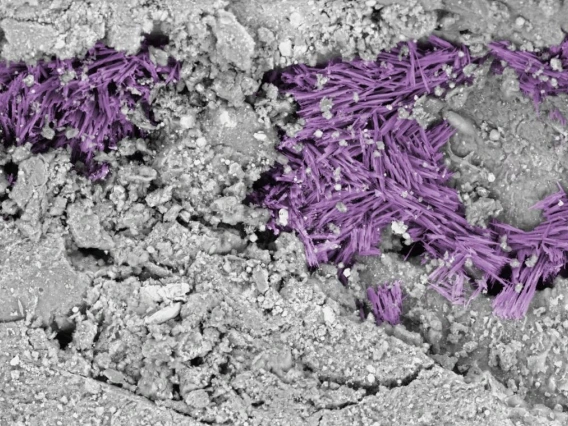
Asteroid Bennu Comes From a Long-lost Salty World With Ingredients For Life
Two research publications by the OSIRIS-REx sample analysis team suggest that conditions for the emergence of life were widespread across the early solar system.Asteroid Bennu Comes From a Long-lost Salty World With Ingredients For Life
×By NASA and Daniel Stolte/University Communications - January 29, 2025
Nature had the conditions to "cook up" the chemical precursor ingredients for life before Earth formed, according to two studies published by the sample analysis team of NASA's OSIRIS-REx mission, which is led by Dante Lauretta at the University of Arizona.
The OSIRIS-REx spacecraft returned a sample from asteroid Bennu in 2023, and following a year of in-depth analyses in labs across the globe, researchers conclude that these conditions and ingredients may have been common across the solar system, increasing the odds of life forming on other planets and moons.
"These samples from Bennu are an incredible discovery, showing that the building blocks of life were widespread across the early solar system," said Lauretta, Regents Professor of Planetary Science and Cosmochemistry at the U of A Lunar and Planetary Laboratory and a co-author on both papers. "By studying how these ingredients interacted in environments like those on Bennu and in places inferred for the early Earth – such as salty ponds similar to those Darwin once imagined – we can better understand how life might emerge and where to search for it beyond our planet."
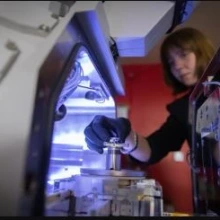
Zoe Zeszut, lab manager and research scientist at the University of Arizona Kuiper-Arizona Laboratory for Astromaterials Analysis, prepares a vial containing extraterrestrial sample material for analysis.
Bennu coalesced from a small portion of the leftover rubble resulting from a giant collision of asteroids. Preserved in the vacuum of space since the solar system's formation about 4.5 billion years ago, the samples have provided scientists with unparalleled insights into the conditions of that era.
Based on their findings, presented in two publications in Nature and Nature Astronomy on Jan. 29, the researchers share several theories about the history of Bennu and the solar system.
Bennu’s molecular composition suggests the ice and organic compounds in its parent body originated in the extremely cold outermost disk of gas and dust that gave rise to the solar system.
Temperatures in the outer disk could dip to minus 400 degrees Fahrenheit, allowing volatile gases that easily evaporate in warmer conditions to accumulate and freeze – among them water vapor, carbon dioxide, methane and ammonia, which was detected in "exceptionally high" abundances in the Bennu samples, according to the Nature Astronomy paper.
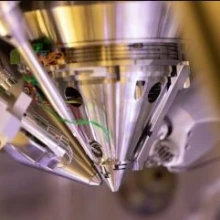
Up-close image of a combined focused ion beam and secondary electron microscope in the Kuiper-Arizona Laboratory for Astromaterials Analysis. This instrument allows scientists to first scan a sample to find an interesting target, then cut it into cross sections.
Given the right environment, ammonia can react with formaldehyde, which was also detected in the samples, to form complex molecules such as amino acids – the building blocks of proteins. Fourteen of the 20 amino acids that life on Earth uses to make proteins are found in the Bennu sample. The research team also found all five nucleobases that life on Earth uses to encode structural information in more complex biomolecules like DNA and RNA.
"Besides pointing to the outer solar system origin of abundant ammonia in Bennu's ancestor, our work also supports the idea that objects that formed far from the sun could have been an important source of the raw ingredients for life throughout the solar system," said Danny Glavin, a senior sample scientist at NASA's Goddard Space Flight Center in Greenbelt, Maryland. Glavin, together with colleague Jason Dworkin, led the paper in Nature Astronomy.
With life's ingredients found in Bennu samples, the big question is: How did these building blocks turn into the chains of molecules needed to activate biology?
"You can have all the ingredients for whatever you want to make, but you have to have the environment to make them do something," said Tim McCoy, curator of meteorites at the Smithsonian's National Museum of Natural History in Washington, D.C.
Along with Sara Russell of the Natural History Museum in London, McCoy co-led 66 scientists from four continents in a study of minerals in the Bennu samples. In the Nature paper, they describe evidence of an ancient environment well-suited to kickstart the chemistry of life.
Ranging from calcite to halite and sylvite, scientists identified 11 minerals that comprise a complete set of "evaporites" from a brine, or salt-saturated water. These evaporites form as water containing dissolved salts evaporates over long periods of time, leaving behind the salts as solid crystals.
"We're seeing minerals in Bennu samples that we have never seen before in a meteorite or any extraterrestrial sample," McCoy said.
Finding evaporites indicates that the interior of Bennu's ancestor was warm enough to support liquid water for a substantial amount of time. Liquid water is necessary for life, as it facilitates its essential chemical reactions, while salts can prevent water from freezing. Salts also help concentrate simple molecules, making it easier for them to combine into the complex compounds life depends on.
While several evaporites have been reported from meteorite samples, the Bennu sample represents the first time researchers have seen a complete set preserving an evaporation process that could have lasted thousands of years or more. This process happens in basins of water on Earth, including drying lakes and shallow seas. The researchers deem it possible that on Bennu's ancestor, water could have existed in underground pockets or veins, but not on the surface, as it would have quickly boiled away due to lack of atmospheric pressure.
U of A co-authors on the two publications include Jessica Barnes, Harold Connolly, Dani DellaGiustina, Pierre Haenecour, Dolores Hill, Tom Zega and Zoe Zeszut, all of whom helped with sample analysis taking advantage of the advanced technological resources of U of A's Kuiper-Arizona Laboratory for Astromaterials Analysis. The following graduate students also were part of this work: Maizey Benner, Kana Ishimaru, Nicole Kerrison, Iunn Ong, Beau Prince, Lucas Smith.
UA News - Asteroid Bennu Comes From a Long-lost Salty World With Ingredients For Life
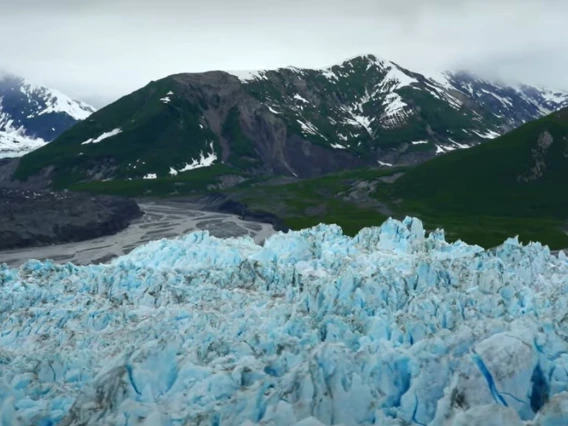
Snow4Flow: Studying Glaciers From Arizona
Snow4Flow is a new University of Arizona-led NASA mission to study arctic glaciers using advanced radar mounted on low-flying aircraft. Captained by Jack Holt, a professor at the University of Arizona’s Lunar & Planetary Lab, the mission’s goal is to improve climate modeling and to better understand glacial loss and its impact on sea level rise.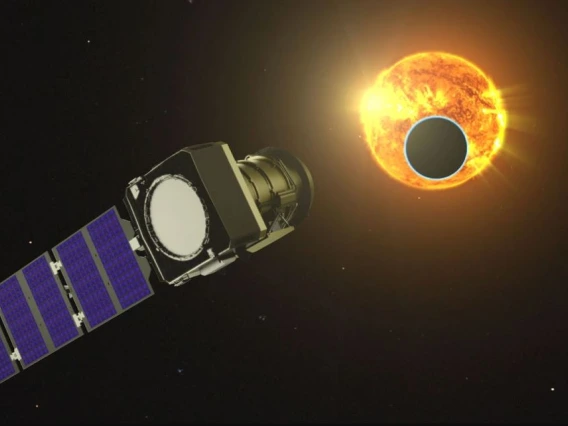
NASA's Pandora Mission One Step Closer to Probing Alien Atmospheres, With Mission Operations Based at U of A
Pandora, a small satellite mission poised to provide in-depth study of at least 20 known planets orbiting distant stars to determine the composition of their atmospheres cleared an important milestone by completing the spacecraft bus, which acts as the spacecraft's "brains."NASA's Pandora Mission One Step Closer to Probing Alien Atmospheres, With Mission Operations Based at U of A
×By Francis Reddy/NASA Goddard Space Flight Center and Daniel Stolte/University Communications - January 16, 2025.
Pandora, NASA's newest exoplanet mission, is one step closer to launch with the completion of the spacecraft bus, which provides the structure, power and other systems that will allow the mission to carry out its work. Pandora's exoplanet science working group is led by the University of Arizona, and Pandora will be the first mission to have its operations center at the U of A Space Institute.
The completion of the bus was announced Thursday during a press briefing at the 245th Meeting of the American Astronomical Society in National Harbor, Maryland.
"This is a huge milestone for us and keeps us on track for a launch in the fall," said Elisa Quintana, Pandora's principal investigator at NASA's Goddard Space Flight Center in Greenbelt, Maryland. "The bus holds our instruments and handles navigation, data acquisition and communication with Earth – it's the brains of the spacecraft."
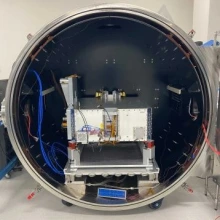
Pandora is a small satellite poised to provide in-depth study of at least 20 known planets orbiting distant stars to determine the composition of their atmospheres – especially the presence of hazes, clouds and water. The data will establish a firm foundation for interpreting measurements by NASA's James Webb Space Telescope and future missions aimed at searching for habitable worlds.
"Although smaller and less sensitive than Webb, Pandora will be able to stare longer at the host stars of extrasolar planets, allowing for deeper study," said Pandora co-investigator Daniel Apai, professor of astronomy and planetary sciences at the U of A Steward Observatory and Lunar and Planetary Laboratory who leads the mission's Exoplanets Science Working Group. "Better understanding of the stars will help Pandora and its 'big brother,' the James Webb Space Telescope, disentangle signals from stars and their planets."
Astronomers can sample an exoplanet's atmosphere when it passes in front of its star as seen from Earth's perspective, during an event known as a transit. Part of the star's light skims the planet's atmosphere before making its way to the observer. This interaction allows the light to interact with atmospheric substances, and their chemical fingerprints – dips in brightness at characteristic wavelengths – become imprinted in the light.
The concept of Pandora was born out of necessity to overcome a snag in observing starlight passing through the atmospheres of exoplanets, Apai said.
"In 2018, a doctoral student in my group, Benjamin Rackham – now an MIT research scientist – described an astrophysical effect by which light coming directly from the star muddies the signal of the light passing through the exoplanet's atmosphere," Apai explained. "We predicted that this effect would limit Webb's ability to study habitable planets."
Telescopes see light from the entire star, not just the small amount grazing the planet. Stellar surfaces aren't uniform. They sport hotter, unusually bright regions called faculae and cooler, darker regions similar to the spots on our sun, both of which grow, shrink and change position as the star rotates. As a result, these "mixed signals" in the observed light can make it difficult to distinguish between light that has passed through an exoplanet's atmosphere and light that varies based on a star's changing appearance. For example, variations in light from the host star can mask or mimic the signal of water, a likely key ingredient researchers look for when evaluating an exoplanet's potential for harboring life.
Using a novel all-aluminum, 45-centimeter-wide telescope, jointly developed by Lawrence Livermore National Laboratory and Corning Specialty Materials in Keene, New Hampshire, Pandora's detectors will capture each star's visible brightness and near-infrared spectrum at the same time, while also obtaining the transiting planet's near-infrared spectrum. This combined data will enable the science team to determine the properties of stellar surfaces and cleanly separate star and planetary signals.
The observing strategy takes advantage of the mission's ability to continuously observe its targets for extended periods, something flagship observatories like Webb, which offer limited observing time due to high demand, cannot regularly do.
Over the course of a yearlong mission, Pandora will observe at least 20 exoplanets 10 times, with each stare lasting a total of 24 hours. Each observation will include a transit, which is when the mission will capture the planet's spectrum.
Karl Harshman, who leads the Mission Operations Team at the U of A Space Institute that will support the spacecraft's operation, said: "We have a very excited team that has been working hard to have our Mission Operations Center running at full speed at the time of launch and look forward to receiving science data. Just this week, we performed a communications test with our antenna system that will transmit commands to Pandora and receive the telemetry from the spacecraft."
Pandora is led by NASA's Goddard Space Flight Center. Lawrence Livermore National Laboratory provides the mission's project management and engineering. Pandora's telescope was manufactured by Corning and developed collaboratively with Livermore, which also developed the imaging detector assemblies, the mission's control electronics, and all supporting thermal and mechanical subsystems. The infrared sensor was provided by NASA Goddard. Blue Canyon Technologies provided the bus and is performing spacecraft assembly, integration and environmental testing. NASA's Ames Research Center in California's Silicon Valley will perform the mission's data processing. Pandora's mission operations center is located at the U of A, and a host of additional universities support the science team.
UA News - NASA's Pandora Mission One Step Closer to Probing Alien Atmospheres, With Mission Operations Based at U of A
